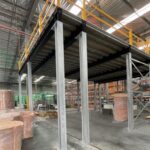In warehouses and other industrial settings, space can be at a premium. Because of this, finding creative ways to maximise or increase space can often be a good idea. This is where warehouse mezzanine floors come in. Mezzanine are an affordable and easy way to expand floor space upwards, increasing the available space in a warehouse.
Come an learn a few facts about mezzanine floors, how they’re built, and whether they’re right for your business.
Mezzanines Can Be Designed And Built Offsite
Although getting a mezzanine installed can add a lot of convenience to a business, having one put in can disrupt the business when it’s being built. The area of the warehouse where the mezzanine is being installed needs to be cleared, and other areas may also need to be cleared to allow materials and workers in.
To minimise disruption, many of the components to build the mezzanine can be fabricated off site. This means that when it comes to actually installing the mezzanine itself, the time it takes to put it up is significantly reduced, meaning the business can get back operating as normal more quickly.
Whenever we’re doing a mezzanine project for a client, we always try to plan things out to allow for as much off site fabrication as possible. This means the new mezzanine is installed quickly and easily when on site.
Mezzanines Can Be Designed For A Variety Of Uses
A lot of people think of a mezzanine level as simply just extra storage, but they can be so much more. Industrial shelving can be installed on a mezzanine level, turning it into a perfect picking and packing area, for example. Mezzanines don’t even need to be used for storage either; they can be used for break areas or general meeting areas so that other floor space can be used for more operational purposes.
Mezzanine levels can also be integrated with conveyor systems, making it easier to transport goods from the floor up to the mezzanine or vice versa. Another common set up mezzanine levels is to have them supported by pallet racking. This allows for pallet storage at ground level with some other use, like shelving, on the level itself.
Mezzanine Levels Can Be Designed For Different Weights
What the mezzanine level is being used for will change what weight it’s designed for. If a mezzanine is only going to be used for light duty, there’s no reason to design the mezzanine for very large weights. On the other hand, if the mezzanine is going to be storing heavy items, it’s important that it’s safe for use.
Because of this, when considering a mezzanine for your business, it’s important to plan for what it’s going to be used for as well as plan for the future should you anticipate the use of the mezzanine level will change. There are a lot of options available, so it’s important to talk about this with your installed.
Mezzanine Levels Can Be Removed At The End Of A Lease
One of the biggest benefits of a mezzanine floor is that it can be made semi-permanent so that they can be removed at the end of a lease. All of this means that a business can get the extra storage they need without having to move to a bigger premises but, at the same time, if the business ever needs to move, they can easily return their old warehouse to its original condition. And you may be able to bring your old mezzanine level with you to your new location.
Get In Touch To Talk About Your Mezzanine Needs
If you’re considering installing a mezzanine in your business, get in touch with us today. We can go over your needs and design something to suit.




